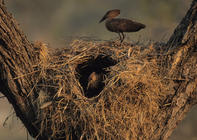Enormous Mansions

Hamerkops are esteemed for their enormous nests, which may contain material including sticks 1.5 m in length and assortments of human debris such as bicycle tyre tubes. The nests are usually built in the main fork of a large tree near water, which is where the hamerkops earn a keep, specializing on feeding on frogs and tadpoles. The giant-sized mansion is constructed as a territorial marker to indicate to intruders that the region is occupied. Since it is constructed in a team effort by male and female, it may also serve to reinforce their pair bond.
The nest begins as a V-shaped cup in the fork of the tree and the sides are gradually built up basket-like around an internal cavity. The roof is the real masterpiece and is constructed with one bird inside and one bird outside the nest.
Sticks, reeds and grass are added vertically and horizontally until the network is solid and a meter thick. So expert is the roof construction that it can support the weight of a fully grown man let-alone the usurpers such as Verreaux’s eagle-owls that often occupy the roofs of the hamerkop’s nest, using them as their own nests.
Good Insulation
The internal chamber is lined with mud to provide insulation for the eggs and chicks while the parents are frogging. A mud-lined upward-facing tunnel leads to the entrance that faces centrally outwards to make it inaccessible to predators. The 80 cm wide chamber can accommodate both adults and youngsters during the night. Early in the morning, the birds shoot out of the tunnel, like erupting corks, returning late afternoon with an upward dive, folding the wings at the last minute.
The finished structure weighs anywhere between 25 kg and 50 kg. It is up to two meters high and one and a half meters wide. The construction takes six weeks, sometimes longer, to complete with 50-60 trips made in an hour to collect material. In spite of the amazing building statistics, hamerkops may choose to rebuild the following year or even build again the same year.
Some remain in the same home for years. Many creatures including barn owls, eagle owls, Egyptian geese, comb ducks, tree squirrels, genets, monitor lizards, snakes and bees make use of the valuable real estate provided by hamerkops, irrespective of whether they are disused or still occupied.
By Megan Emmet